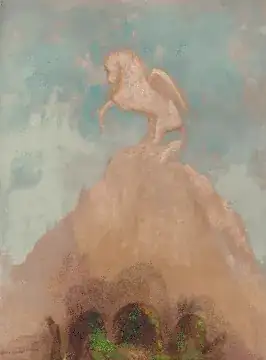To expand on C. M. Weimer's explanation, it may be that the monster depicted at the bottom is indeed Chimera. This seems to be a subject that Redon was well acquainted with. A writeup from an auction in 2001 displays a similar work by Redon "Pégase blanc":

Pégase blanc
The similarity in the layout of the work seems quite striking to me, especially the undulating serpentine form of the Chimera half-obscured at the bottom. The writeup includes a note that the bottom figure is often mistaken for Hydra, but is in fact Chimera.
Twisting on the ground below is the serpent Chimaera (sometimes misidentified as Hydra, which the hero Hercules vanquished in another myth.)
My guess? The work in question probably never had an actual given title. I can't find any resource to establish this with certainty, but untitled works are hardly uncommon. So it's probable that the work is, in fact, intended to be Pegasus and Chimera, but has an unfortunate history of being mislabeled.
In further support, here are a couple of other works by Redon which depict Chimera explicitly, and show a tendency to diverge from more traditional renderings of the creature, and display strongly serpentine qualities:

From "To Gustave Flaubert" album
Le sphinx:
Mon regard que rien ne peut dévier, demeure tendu à travers
les choses sur un horizon inaccessible.
La chimère:
Moi, je suis légère et joyeuse!

La chimère regarde avec effroi toutes choses
From the portfolio "La Nuit"
And to provide a bit more evidence of his awareness of the story of Pegsus with Bellerophon and the Chimera, we have a depiction of Pegasus and Bellerophon, from the Met:

Pegasus and Bellerophon





